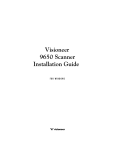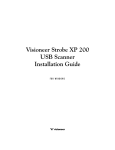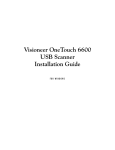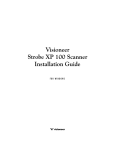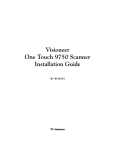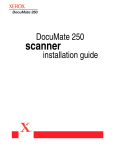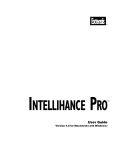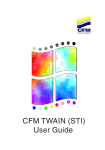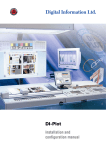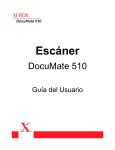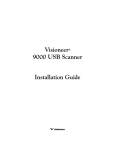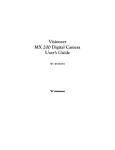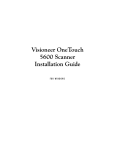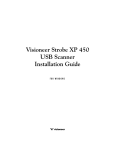Download Visioneer 9650 Installation guide
Transcript
Visioneer 9650 Scanner Installation Guide FOR WINDOWS COPYRIGHT INFORMATION Copyright © 2001 Visioneer, Inc. Reproduction, adaptation, or translation without prior written permission is prohibited, except as allowed under the copyright laws. The Visioneer brand name and logo are registered trademarks of Visioneer, Inc. The PaperPort brand name and logo are registered trademarks of ScanSoft, Inc. Microsoft is a U.S. registered trademark of Microsoft Corporation. Windows is a trademark of Microsoft Corporation. TextBridge is a registered trademark of ScanSoft, Inc. ZyINDEX is a registered trademark of ZyLAB International, Inc. ZyINDEX toolkit portions, Copyright © 1990-1998, ZyLAB International, Inc. All Rights Reserved. All other products mentioned herein may be trademarks of their respective companies. Information is subject to change without notice and does not represent a commitment on the part of Visioneer. The software described is furnished under a licensing agreement. The software may be used or copied only in accordance with the terms of such an agreement. It is against the law to copy the software on any medium except as specifically allowed in the licensing agreement. No part of this document may be reproduced or transmitted in any form or by any means, electronic or mechanical, including photocopying, recording, or information storage and retrieval systems, or translated to another language, for any purpose other than the licensee's personal use and as specifically allowed in the licensing agreement, without the express written permission of Visioneer. Part Number: 05-0486-000 Restricted Rights Legend Use, duplication, or disclosure is subject to restrictions as set forth in contract subdivision (c)(1)(ii) of the Rights in Technical Data and Computer Software Clause 52.227-FAR14. Material scanned by this product may be protected by governmental laws and other regulations, such as copyright laws. The customer is solely responsible for complying with all such laws and regulations. Visioneer's Limited Product Warranty If you find physical defects in the materials or the workmanship used in making the product described in this document, Visioneer will repair, or at its option, replace, the product at no charge to you, provided you return it (postage prepaid, with proof of your purchase from the original reseller) during the 12-month period after the date of your original purchase of the product. THIS IS VISIONEER'S ONLY WARRANTY AND YOUR EXCLUSIVE REMEDY CONCERNING THE PRODUCT, ALL OTHER REPRESENTATIONS, WARRANTIES OR CONDITIONS, EXPRESS OR IMPLIED, WRITTEN OR ORAL, INCLUDING ANY WARRANTY OF MERCHANTABILITY, FITNESS FOR A PARTICULAR PURPOSE OR NON-INFRINGEMENT, ARE EXPRESSLY EXCLUDED. AS A RESULT, EXCEPT AS SET OUT ABOVE, THE PRODUCT IS SOLD “AS IS” AND YOU ARE ASSUMING THE ENTIRE RISK AS TO THE PRODUCT'S SUITABILITY TO YOUR NEEDS, ITS QUALITY AND ITS PERFORMANCE. IN NO EVENT WILL VISIONEER BE LIABLE FOR DIRECT, INDIRECT, SPECIAL, INCIDENTAL OR CONSEQUENTIAL DAMAGES RESULTING FROM ANY DEFECT IN THE PRODUCT OR FROM ITS USE, EVEN IF ADVISED OF THE POSSIBILITY OF SUCH DAMAGES. All exclusions and limitations in this warranty are made only to the extent permitted by applicable law and shall be of no effect to the extent in conflict with the express requirements of applicable law. FCC Radio Frequency Interference Statement This equipment has been tested and found to comply with the limits for the class B digital device, pursuant to part 15 of the FCC Rules. These limits are designed to provide reasonable protection against interference in a residential installation. This equipment generates, uses and can radiate radio frequency energy and if not installed, and used in accordance with the instructions, may cause harmful interference to radio communications. However, there is no guarantee that interference will not occur in a particular installation. If this equipment does cause harmful interference to radio or television reception, which can be determined by turning the equipment off and on, the user is encouraged to try and correct the interference by one or more of the following measures: • Reorient or relocate the receiving antenna. • Increase the separation between the equipment and receiver. • Connect the equipment into an outlet on a circuit different from that to which the receiver is connected. • Consult the dealer or an experienced radio/TV technician for help. This equipment has been certified to comply with the limits for a class B computing device, pursuant to FCC Rules. In order to maintain compliance with FCC regulations, shielded cables must be used with this equipment. Operation with non-approved equipment or unshielded cables is likely to result in interference to radio and TV reception. The user is cautioned that changes and modifications made to the equipment without the approval of manufacturer could void the user's authority to operate this equipment. This device complies with part 15 of the FCC Rules. Operation is subject to the following two conditions: (1) This device may not cause harmful interference, and (2) this device must accept any interference received, including interference that may cause undesired operation. TABLE OF CONTENTS i TA B L E O F C O N T E N T S Welcome . . . . . . . . . . . . . . . . . . . . . . . . . . . . . . . . . . . . . . . . . . . . . . 5 What’s in the Box . . . . . . . . . . . . . . . . . . . . . . . . . . . . . . . . . . . . . . . 5 The Visioneer 9650 Scanner . . . . . . . . . . . . . . . . . . . . . . . . . . . . . . . 6 What You Need . . . . . . . . . . . . . . . . . . . . . . . . . . . . . . . . . . . . . . . . . 8 Getting the PaperPort Online Documentation . . . . . . . . . . . . . . . . . 8 Installing . . . . . . . . . . . . . . . . . . . . . . . . . . . . . . . . . . . . . . . . . . . . . . 9 Step 1: Assemble the Scanner . . . . . . . . . . . . . . . . . . . . . . . . . . . . . . . 9 Step 2: Install the Software . . . . . . . . . . . . . . . . . . . . . . . . . . . . . . . 12 Step 3: Connect the Scanner . . . . . . . . . . . . . . . . . . . . . . . . . . . . . . 13 Step 4: Set Up the Software to Scan . . . . . . . . . . . . . . . . . . . . . . . . . 17 Scanning . . . . . . . . . . . . . . . . . . . . . . . . . . . . . . . . . . . . . . . . . . . . . 19 Loading Documents to Scan . . . . . . . . . . . . . . . . . . . . . . . . . . . . . . 19 Scanning Items . . . . . . . . . . . . . . . . . . . . . . . . . . . . . . . . . . . . . . . . 21 Adjusting the Image with the Scan Manager . . . . . . . . . . . . . . . . . . 24 Adjusting the Color Mode, Resolution, Brightness and Contrast 24 Adjusting the Output Size . . . . . . . . . . . . . . . . . . . . . . . . . . . . . 26 Manually Setting the Scan Area . . . . . . . . . . . . . . . . . . . . . . . . . 28 Reversing the Image . . . . . . . . . . . . . . . . . . . . . . . . . . . . . . . . . 30 Adjusting Color and Gray Images . . . . . . . . . . . . . . . . . . . . . . . 31 Manually Adjusting Color Settings . . . . . . . . . . . . . . . . . . . . . . 33 Clearing Paper Jams . . . . . . . . . . . . . . . . . . . . . . . . . . . . . . . . . . . . . 38 Care and Maintenance . . . . . . . . . . . . . . . . . . . . . . . . . . . . . . . . . . . 39 Cleaning the Scanner Glass . . . . . . . . . . . . . . . . . . . . . . . . . . . . 39 Cleaning the Automatic Document Feeder . . . . . . . . . . . . . . . . 39 Replacing the ADF Pad Assembly . . . . . . . . . . . . . . . . . . . . . . . 40 Troubleshooting . . . . . . . . . . . . . . . . . . . . . . . . . . . . . . . . . . . . . . . 41 How to Uninstall Your Scanner . . . . . . . . . . . . . . . . . . . . . . . . . . . . 43 Step 1: Uninstalling the Visioneer 9650 Software . . . . . . . . . . . 43 ii TABLE OF CONTENTS Step 2: Uninstalling the PaperPort Software . . . . . . . . . . . . . . . 46 Contacting Visioneer America Technical Support . . . . . . . . . . . . . . 47 Contacting Visioneer—International Technical Support . . . . . . . . . 48 Visioneer 9650 Scanner Specifications . . . . . . . . . . . . . . . . . . . . . . . 49 Visioneer 9650 Scanner Parts List . . . . . . . . . . . . . . . . . . . . . . . . . . 50 WELCOME Congratulations on purchasing your Visioneer 9650 scanner. With this scanner, you can quickly scan stacks of items, single pages, color photos, or other paper items to place their electronic images on your computer. WHAT’S IN THE BOX Before starting the assembly and installation, check the contents of the box to make sure that all parts are included. If any items are missing or damaged, contact the dealer where you purchased the scanner. Visioneer 9650 Scanner Paper Guide Paper Stop USB cable Paper Guide Extension Installation Guide Installation CD Power cable Power supply Replaceable ADF Pad VISIONEER 9650 SCANNER INSTALLATION GUIDE 5 6 VISIONEER 9650 SCANNER INSTALLATION GUIDE THE VISIONEER 9650 SCANNER Document Cover Document Pad Glass Reference Frame Paper Stop Paper Guide Extension Paper Guide Automatic Document Feeder Lock (on underside of scanner) Status Lights USB Port ADF port Power jack Power On/Off Switch ADF Cable THE VISIONEER 9650 SCANNER Document Cover. Close the document cover after placing items on the scanner glass. Document Pad. Helps to secure the document in place on the scanner glass. Reference Frame. Place items face down within this frame. Markings on the border of the frame show where to align various paper sizes. Glass. Place items face down aligned at the upper left corner of the glass. Paper Stop. Holds items in place as they are ejected from the Automatic Document Feeder. Adjust the stop for either letter-sized or legal-sized pages. Paper Guide Extension. Unfolds to support multiple pages to scan. Paper Guide. Holds pages in place. Adjust the guide to fit the size of the paper to scan. Automatic Document Feeder (ADF). Feeds one page at a time onto the glass for scanning. Lock. Locks or unlocks the scanning head. The lock is located on the underside of the scanner. Status Lights. Shows the scanner’s status. Flashing Green lights: scanner is preparing itself or lamp is warming up. Steady Green lights: scanner is on and ready to scan. Check light on: scanner is malfunctioning. USB Port. Plug one end of the USB cable into this port; plug the other end into a USB port on the computer, keyboard, or a USB hub. ADF Port. Plug the ADF cable from the Automatic Document Feeder into this port. Power Jack. Plug the power cord into this jack. Power On/Off Switch. Turns scanner’s power on and off. ADF Cable. Supplies power from the scanner body to the Automatic Document Feeder. 7 8 VISIONEER 9650 SCANNER INSTALLATION GUIDE WHAT YOU NEED To use the scanner and software, you need the following: ■ IBM PC (or 100-percent compatible) Pentium or equivalent ■ Microsoft Windows 98, Windows 2000, Windows Me, or Windows XP ■ One available Universal Serial Bus (USB) port on your computer ■ Available internal memory (RAM): ■ Windows 98—32 megabytes (MB) or more ■ Windows 2000, Me, or XP—64 MB or more; 128 MB recommended for Windows XP ■ 70 MB of free hard disk space ■ A VGA or SVGA monitor. Recommended settings for your monitor are as many colors as possible—High Color (16-bit), True Color (24-bit or 32-bit). Set the resolution to at least 800 by 600 pixels. To set your monitor’s colors and resolution, open the Windows Control Panel, double-click Display, and then click the Settings tab. ■ A CD-ROM drive GETTING THE PAPERPORT ONLINE DOCUMENTATION The Installation CD also includes your ScanSoft PaperPort User’s Guide. This guide provides more detailed information about PaperPort’s features. Please see the CD to view the manual. You can also print the manual from the CD. STEP 1: ASSEMBLE THE SCANNER 9 Installing Installation is a quick, four-step process: ■ assemble the scanner ■ install the software ■ connect the scanner to your computer ■ set up the PaperPort software to scan with your scanner. STEP 1: ASSEMBLE THE SCANNER All the components to assemble the scanner are included in the box. To assemble the scanner: 1. Remove all shipping tape from the top and bottom of the scanner. 10 VISIONEER 9650 SCANNER INSTALLATION GUIDE 2. Slide the locking tab on the bottom of the scanner to its unlocked position. Unlocked position Note: The locking tab protects the scanner’s scan head by holding it securely in position. Lock the scanner when transporting it from one location to another, but always remember to unlock it before scanning. The scanner will not scan when locked. 3. Insert the slots (A) on the Paper Guide onto their tabs (B) on the scanner and slide the Guide down into place. The catch tabs (C) “snap” into place. Refer to the picture on page 6 to see the location of the assembled parts. A B C STEP 1: ASSEMBLE THE SCANNER 11 4. Insert the Paper Guide Extension into the Paper Guide and “snap” its tabs into place. 5. Insert the Paper Stop onto the back of the scanner and slide it downward to “snap” its tabs into place. You’re now ready to install the software. 12 VISIONEER 9650 SCANNER INSTALLATION GUIDE STEP 2: INSTALL THE SOFTWARE The PaperPort CD includes all the necessary installation files, as well as the PaperPort software files and other software files. To install the scanner software: 1. Start Microsoft Windows and make sure that no other applications are running. 2. Insert the CD into your computer’s CD-ROM drive. The CD automatically starts. Note: If the CD does not automatically start, make sure the CD drive’s door is completely shut. If the CD still doesn’t start, click the Windows icon that shows the drives on your computer. (Usually, the icon is named My Computer.) The window shows the drives available on your computer. Double-click the icon for your CD-ROM drive to see the list of files on the CD. Double-click the file named START32.EXE. The CD starts. 3. From the list of options that appears on the screen, select ScanSoft PaperPort. 4. Select Install ScanSoft PaperPort. STEP 3: CONNECT THE SCANNER 13 5. Follow the instructions on the screen to install the PaperPort software on your computer. During installation, a message instructs you to connect the scanner to the computer. When you’re finished connecting the scanner as described below, click Finish in the dialog box. STEP 3: CONNECT THE SCANNER Your Visioneer 9650 scanner connects to any available USB port. Check your computer’s manual for the USB port locations. Note: You do not have to shut off the power to your computer when connecting the scanner to a USB port. 14 VISIONEER 9650 SCANNER INSTALLATION GUIDE To connect the scanner: 1. Plug the ADF cable into the ADF port on the body of the scanner. 2. Plug the power supply into its power port on the scanner. 3. Plug the power cord into the power supply and then into a wall outlet. STEP 3: CONNECT THE SCANNER 15 4. Plug the USB cable into the USB port on the scanner. The USB port is identified by its USB symbol. 5. Plug the USB cable into a USB port on the computer, keyboard, or into a USB hub. If the plug does not attach easily, make sure that you are plugging it in correctly. Do not force the plug into the connection. Note: If you have not installed the software yet, unplug the USB cable from the computer and install the software now. When the software installation is complete a message tells you to connect the scanner. 16 VISIONEER 9650 SCANNER INSTALLATION GUIDE 6. Turn on the power switch. The status lights come on and flash indicating that the scanner is receiving power. Your computer recognizes that a scanner has been plugged into the USB port and automatically loads the appropriate software to run the scanner. 7. Click the Finish button on the dialog box on the computer screen. The scanner’s Power and Ready lights are green when the scanner and computer are communicating properly. That completes the steps to connect your scanner to the computer. 8. If you removed the CD from the CD drive and want to install other software, reinsert the CD into the drive. In addition to installing the other software from the CD, you can also view and print the User Guides. Remove the CD from the computer when you’re finished and store it in a safe place. STEP 4: SET UP THE SOFTWARE TO SCAN 17 STEP 4: SET UP THE SOFTWARE TO SCAN To set up the PaperPort software, you must first select the Visioneer 9650 scanner as the scanning source. Note: You can also scan with other software that meets the Twain standards for scanning, which includes many graphics and imaging applications. The following steps show how to set up the PaperPort software but you use the same basic process with other Twain software. To set up the software: 1. Double-click the PaperPort icon on the Windows Desktop to start PaperPort. The PaperPort Desktop appears. 18 VISIONEER 9650 SCANNER INSTALLATION GUIDE 2. From the File menu, choose Select Source. The Select Source dialog box appears, listing all Twain devices installed on your computer. Twain devices include scanners, digital cameras, and other equipment that can capture images for your computer. Twain is a standard method that computers use to receive images from those devices. 3. Choose Visioneer 9650, and then click Select. Your scanner is now set to scan. LOADING DOCUMENTS TO SCAN 19 Scanning This section explains how to scan documents with your Visioneer 9650 scanner. LOADING DOCUMENTS TO SCAN Your scanner can scan a stack of documents or a single item. To load a stack of documents in the Automatic Document Feeder: 1. Unfold the Paper Guide Extension and adjust the Paper Guide for the size of paper. You can also adjust the Paper Stop at the back of the scanner for the size of the paper. Pull out the slide on the Stop for letter-sized pages. Push it in for legal-sized pages. Note: Remove any staples or paper clips from the documents before loading them into the Automatic Document Feeder. Staples and paper clips can jam the feed mechanism and scratch the glass. 20 VISIONEER 9650 SCANNER INSTALLATION GUIDE 2. Load your stack of documents face up, with their tops into the Automatic Document Feeder. To load a single item: 1. Place the item on the scanner glass, face down. 2. Align the item with the arrow on the reference frame. 3. Close the cover. SCANNING ITEMS 21 SCANNING ITEMS You scan from the PaperPort software (or other Twain software). To scan an item: 1. If the PaperPort software isn’t currently running, double-click the PaperPort icon on the Windows desktop to start it. The PaperPort Desktop appears. 2. Click the Twain icon on the PaperPort software’s Command Bar, or choose Acquire from the File menu. The Scan Manager appears. 22 VISIONEER 9650 SCANNER INSTALLATION GUIDE 3. From the scanner drop-down menu, choose whether you are going to scan a single item (Flatbed) or a stack of items (ADF). Choose Flatbed to scan a single item Click Preview to check the image Click Scan when you’re ready to scan Choose ADF to scan a stack of documents 4. If you want to see what the scanned image will look like before scanning its final image, click the Preview button. The scanner scans a preview of the item and displays it in the Scan Manager. The example below shows a color photograph to scan. Note: If you preview when scanning a stack of documents, the first page of the stack feeds through the ADF for the preview. After adjusting the scanner settings, replace that page on the stack so it is scanned with the rest of the pages. SCANNING ITEMS 23 You can now fine-tune the options on the Scan Manager for the item you’re scanning. For example, to change the brightness or contrast of the scanned image, drag the Dark/Light or Low/High sliders. 5. If you want to preview the item again with the new settings, click the Preview button again on the Scan Manager. 6. When you are satisfied with the preview image, click the Scan button on the Scan Manager. The scanned item appears as a thumbnail image in the ScanSoft PaperPort Desktop. A thumbnail image of the scanned item appears on the PaperPort Desktop Thumbnail images of a stack of documents scanned with the ADF. On the PaperPort Desktop: ■ The name of the scanned image is the day, date, and number of scanned items that day. For example, in the sample above, the stack of documents is the second scanned item so it is followed by a (2). The first scan is the color photo.To change a name, click it to select its text and type a new name. ■ The thumbnail images of the stack of documents also has scroll arrows so you can click through the pages in the stack. The page counter next to the scroll arrows shows which page you’re viewing and the total number in the stack. To learn more about the PaperPort software please see the ScanSoft PaperPort User’s Guide on the Installation CD that you received with your scanner. 24 VISIONEER 9650 SCANNER INSTALLATION GUIDE ADJUSTING THE IMAGE WITH THE SCAN MANAGER The Scan Manager has a wide variety of options to adjust your scanned images. Using those options you can produce the best possible scan of your documents, color photos, magazine articles, business cards, or any other items you scan. ADJUSTING THE COLOR MODE, RESOLUTION, BRIGHTNESS AND CONTRAST The Scan Manager’s drop-down menus and sliders are for adjusting the color mode, resolution, brightness, and contrast. Color Mode Resolution Brightness Contrast File size COLOR MODE From the Color Mode drop-down menu, select the appropriate color mode for the item(s) you’re scanning: ADJUSTING THE IMAGE WITH THE SCAN MANAGER 25 ■ Black and White—scans in black and white. The scanning pixels are all the same size and are either black or white. Use this setting for letters, memos, pen and ink drawings and other black and white material. This setting produces the smallest file size for scanned items. ■ Halftone—scans the image so it appears to consist of gray tones. A pop-up menu appears so you can choose one of the halftone options. Notice that the preview image changes as you select each option so you can see which one is best for scanning. Halftones produce simulated gray tones by using black and white pixels of different sizes and is often used to produce newspaper and magazine images. Use this setting for lower resolution black and white images. The halftone settings also produce small file sizes. ■ 8-Bit Gray—scans the image using up to 256 true shades of gray. Use this setting to scan black and white photographs and other higher quality black and white images. You can also scan a color photo with this setting to turn its colors into gray shades. The file size is about one third the size of a color scan. ■ 24-Bit Color—scans the image in full color. Use this setting to scan color photographs and other color images. The file size is the largest of the color mode options. Halftone Example Note: You can see the file size at the bottom of the Scan Manager. RESOLUTION Resolution determines the amount of detail you can see in the scanned image. The resolution setting for a scan is in dots-per-inch (dpi). The higher the resolution, the finer the details, however, higher dpi settings also take longer to scan and produce larger files sizes. Usually the higher resolution settings are used for precision work, such as photographs or fine artwork. ■ Click the Resolution drop-down menu and select the resolution for the item. The resolution settings on your Visioneer 9650 scanner range from 50 dpi to 1200 dpi. 26 VISIONEER 9650 SCANNER INSTALLATION GUIDE BRIGHTNESS AND CONTRAST Sometimes an item is scanned with the brightness and contrast set to be too light or too dark. For example, a note written with a light pencil may need to be scanned darker to improve legibility. Brightness refers to the lightness or darkness of the image. Contrast is the range between the darkest and lightest portions of the image. The greater the contrast, the more the difference between the lighter and darker shades in the image. ■ Dark/Light slider—adjusts the brightness of the scan. Drag the slider to the right or left to increase or decrease the brightness. ■ Low/High slider—adjusts the contrast. Drag the slider to the right or left to increase or decrease the contrast. ADJUSTING THE OUTPUT SIZE The output size is the width and height of the image after it is scanned. For example, if you plan to print the image on a piece of paper you can select the output size to be 8.5 by 11.0 inches. Preview Auto-Area Paper Size Units Ruler Units Output Dimensions ADJUSTING THE IMAGE WITH THE SCAN MANAGER 27 PREVIEW AUTO-AREA The item you’re scanning may not fill the scanner glass. In that case you can preview the item and use the Preview Auto-Area button to automatically set the size of the scanned image. ■ Click the Preview Auto-Area button to let the Scan Manager automatically determine the size of the item being previewed. For example, if you preview the scan of a small photo, the Scan Manager automatically determines that the scan area is only where the photo is located on the glass. You can manually adjust the scan area. For example, if you want the scan to include a border around the image, drag the edges of the scan area box. PAPER SIZE If you know the size of the item(s) you’re scanning, set the paper size. This automatically sets the scan size to the paper size. ■ Click the Paper Size button and select the image’s paper size from the pop-up menu. UNITS The ruler around the edges of the image area and the output dimensions can be displayed in inches, centimeters, or pixels. ■ Click the Units button to select the units for the ruler. Clicking the button toggles through the three choices. The ruler and output dimensions change to the new units. 28 VISIONEER 9650 SCANNER INSTALLATION GUIDE MANUALLY SETTING THE SCAN AREA You can manually adjust the output area to scan specific sections of an image. For example, if you’re scanning a photograph and want to focus on one section, manually setting the output size removes the rest of the photograph from the final scanned image. Move pointer Manually set scan area Resize pointer Output Dimensions To manually set an output area: 1. Put the mouse pointer on an edge of the scan area box so it becomes a resize pointer and then drag to set a new size for the box. 2. To move the box, put the mouse pointer inside the box so the pointer becomes a four-headed arrow. Drag to move the box to a new position. 3. The output dimensions change to reflect the new scan area size. Now, when you scan, only the area inside the scan area box is scanned to the PaperPort Desktop. Note: If you want to reset the scan area to the full size of the image again, click the Preview Auto-Area button. ADJUSTING THE IMAGE WITH THE SCAN MANAGER 29 Here’s a sample of a manually selected output area: This is the area manually selected for scanning. This is the image that appears on the PaperPort Desktop when the scanning is finished. Lock Scaling MANUALLY SETTING THE WIDTH AND LENGTH The output dimensions at the bottom of the Scan Manager show the Width and Length of the scan area. You can set the area by typing numbers into those boxes. To manually set the width and length: 1. Click in a box and type a new dimension. 2. Repeat in the other box. The scan area box changes to reflect the new size. 3. To maintain the same width to length ratio, click the Lock Scaling icon next to the dimension. With the Lock Scaling locked, when you type a new width or length, the other setting changes so the relative size of the scan area remains constant. 30 VISIONEER 9650 SCANNER INSTALLATION GUIDE REVERSING THE IMAGE The Scan Manager has an Invert button and a Mirror button for reversing the scanned image. Invert Mirror Invert reverses the black and whites or the colors of an image. Mirroring flips the image 180 degrees. ■ Click the Invert or Mirror button to see the image you want. Original Image Inverted Image Mirrored Image ADJUSTING THE IMAGE WITH THE SCAN MANAGER 31 ADJUSTING COLOR AND GRAY IMAGES The Scan Manager has three buttons—Descreen, Sharpen, and Auto Level—for quickly adjusting color and gray images. These buttons do not apply to black and white or halftone images. Descreen Sharpen Auto Level DESCREEN IMAGE Select this option when scanning a picture from a newspaper or magazine article, sales catalog, or other source that contains images with patterns or dots. Scans of patterns or dots sometimes have a distorted or wavy appearance. The scanner scans the item to compensate for the patterns and dots, and produces a clearer image. The scanning may slow down a bit when this option is selected. You don’t need to select this option when scanning photographs. Original Image Descreened Image 32 VISIONEER 9650 SCANNER INSTALLATION GUIDE To descreen an image: 1. Click the Descreen button. 2. Choose the appropriate option from the Descreen pop-up menu. Watch the preview image as you select various options to see which one is best for your final scanned image. SHARPEN IMAGE Sharpness determines the amount of blur in an image. Your scanner can sharpen an original blurred image by adjusting the blurry edges in sections of the image. To sharpen an image: 1. Click the Sharpen button. 2. Choose the appropriate option from the Sharpen pop-up menu. Original Image Sharpened Image ADJUSTING THE IMAGE WITH THE SCAN MANAGER 33 AUTO LEVEL Your scanner can analyze a color image to automatically determine the best settings to match the colors of the original image. Click this button to let the scanner automatically adjust the color settings. Original Image Auto Level Adjusted MANUALLY ADJUSTING COLOR SETTINGS The buttons for manually adjusting a preview image’s color settings offer several advanced color options. Highlight/Shadow Levels Curves Color Balance Hue/Saturation/Lightness 34 VISIONEER 9650 SCANNER INSTALLATION GUIDE HIGHLIGHT/SHADOW LEVELS Images have light and dark areas. The highlight is the lightest spot on an image; shadow is the darkest spot. The range of colors between the highlight and shadow determines the range of colors of the image. Using the Highlight/Shadow Levels features, however, you can extend the original range of colors between the highlight and shadow to reveal more details in the midrange colors. To adjust the highlight and shadow levels: 1. Click the Highlight/Shadow button. The dialog box that appears shows a histogram of the saturation, gamma, and hue (S, G, H) of the range of colors for the highlight and shadow. Saturation is the strength or purity of a color, gamma controls the brightness of the midtones of the color, and hue is the color your eyes see as reflected from the image. The gamma setting in this dialog box is in conjunction with the hue and saturation but you can also set gamma by itself for an image. See the section “Curves,” below for more information 2. From the Channel drop-down menu, choose RGB to adjust all the channels together, or choose a single channel if available. ADJUSTING THE IMAGE WITH THE SCAN MANAGER 35 3. Enter new settings in the boxes for the three levels, or drag the small triangles at the bottom of the histogram. As you change the settings, the histogram changes to reflect the new levels. 4. Click Preview to see the effect of the new settings on the preview image. 5. Click Reset to reset the levels to their original values. 6. Click OK when the levels are what you want. CURVES Like the Highlight/Shadow levels, the Curves feature also adjusts the range of midtone colors on an image. However, with the Curves feature you can set the gamma individually to adjust midtone levels without losing details from the lightest or darkest areas. To adjust the gamma curve: 1. Click the Curves button. The dialog box that appears shows a plot of the gamma. The gamma of the original image is represented by a straight line from the lower left to upper right corners. Changing the straight line to a curve changes the gamma setting for the midtones on the original image. 36 VISIONEER 9650 SCANNER INSTALLATION GUIDE 2. From the Channel drop-down menu, choose RGB to adjust the gamma of all the channels together, or choose a single channel if available. 3. Drag the line up or down to set a new gamma. The input and output values represent values on the horizontal and vertical axes for the new gamma setting. Click the Curve or Line button to see the display as a smooth curve or a line. You can drag the line at multiple points. 4. Click Preview to see the effect of the new settings on the preview image. 5. Click Reset to reset the levels to their original values. 6. Click OK when the levels are what you want. COLOR BALANCE The color balance refers to the relative amounts of the three primary colors in an image. By adjusting the color balance you can sometimes compensate for an image with too much or too little of a color. To adjust the color balance: 1. Click the Color Balance button. The settings in the dialog box are initially set to zero for each of the colors, indicating no change to the original image’s color balance. 2. Type a number in the color levels boxes to set a new color level, or drag the triangles to the left or right. ADJUSTING THE IMAGE WITH THE SCAN MANAGER 37 Each color is paired with its complementary color, so as you drag a triangle you are increasing a color while decreasing its complementary color. 3. Click Preview to see the effect of the new settings on the preview image. 4. Click Reset to reset the levels to their original values. 5. Click OK when the levels are what you want. HUE/SATURATION/LIGHTNESS Hue is the color your eyes see as reflected from the image, saturation is the strength or purity of a color and determines whether a color is pale or rich, and lightness is the intensity of the color. To adjust the hue/saturation/lightness: 1. Click the Hue/Saturation/Lightness button. The settings in the dialog box are initially set to zero, indicating no change to the original image’s hue, saturation, or lightness. 2. Type a number in the color boxes to set a new levels, or drag the triangles to the left or right. 3. Click Preview to see the effect of the new settings on the image. 4. Click Reset to reset the levels to their original values. 5. Click OK when the levels are what you want. 38 VISIONEER 9650 SCANNER INSTALLATION GUIDE CLEARING PAPER JAMS If your scanner stops scanning due to a paper jam in the Automatic Document Feeder, a warning dialog box appears after a few moments. To clear a paper jam: 1. Open the Automatic Document Feeder cover. 2. Remove the jammed paper and close the cover. To reduce the number of paper jams, smooth and straighten paper before scanning, adjust the guides to the paper size, and insert the paper evenly into the ADF. CARE AND MAINTENANCE 39 CARE AND MAINTENANCE Your scanner is designed to be maintenance-free. Occasional cleaning, however, can help ensure continual optimal performance. CLEANING THE SCANNER GLASS Scanning items that have excessive amounts of dirt or dust may dirty the glass. To ensure the best quality scanned item, wipe the scanner glass with a soft clean cloth to rid the glass of dust or other debris. CLEANING THE AUTOMATIC DOCUMENT FEEDER You may need to clean the ADF feed mechanism if your scanned documents do not feed easily into the ADF, or several feed in at the same time. To clean the ADF: 1. Wet a cotton swab with some isopropyl alcohol (95%). 2. Open the ADF cover. 3. Wipe the feed roller from side to side. Rotate the roller to clean its entire surface. 4. Wipe the pad from top to bottom. Be careful not to snag the swab on the springs on either side of the pad. 5. Close the cover when you’re finished. 40 VISIONEER 9650 SCANNER INSTALLATION GUIDE REPLACING THE ADF PAD ASSEMBLY The ADF pad spring may begin to wear out after 150,000 scanned pages. Problems with documents feeding into the ADF is an indication that the pad spring may be wearing out. You received a replacement pad in the original scanner box, and you can also order a new one. See the “Visioneer 9650 Scanner Parts List” on page 50 for ordering information. To replace the ADF Pad assembly: 1. Open the ADF cover. 2. Squeeze the plastic clamps that hold the pad assembly in place and lift the pad up and out 3. Reverse the procedure to replace the new pad into its slots. TROUBLESHOOTING 41 TROUBLESHOOTING In addition to the troubleshooting information contained in this section, please see the Readme file in the PaperPort directory on your computer’s hard drive. The Readme file contains additional information that may help you diagnose problems with the scanner. If you try all the troubleshooting procedures described in this section and in the Readme file, and the scanner still has problems, you may have a malfunctioning scanner. Please see the technical support card that you received with your scanner for technical assistance telephone numbers. Also visit our web site at www.visioneer.com for additional technical information. Problem: The scanner won’t scan. What’s wrong? Check for one of these possible problems: • Is a cable loose or not plugged in securely? Inspect all cable connections. Make sure all the cables are plugged in securely. • Are the scanner’s status lights on? Turn on the scanner’s power. If the lights still don’t come on, plug the power supply into another electrical outlet. • Is the scanner’s locking tab in the locked position? Slide the locking tab to the unlocked position. If you tried to scan with the scanner locked, you must restart your computer after unlocking the scanner. • Did you restart the computer after installing the software? If you didn’t restart the computer, it may not have loaded all of the software files. Try restarting your computer. • Did you select another Twain source for acquiring images? If you use multiple Twain devices with your computer, you may have selected another source for images. Start the PaperPort software and choose Select Source from the File menu. Choose Visioneer 9650 V1.0 and click Select. 42 VISIONEER 9650 SCANNER INSTALLATION GUIDE Problem: During installation I got the error message: PaperPort Installation is not complete. What do I do? The installation procedure was not successful. You need to reinstall the PaperPort software. Problem: I got the error message: PaperPort cannot allocate enough memory to perform internal critical operations. What do I do? Close any other active applications so that additional memory is available. If you click Continue, PaperPort moves the file to the PaperPort data directory and renames the file with the prefix “bad.” This allows you to recover the file later. To recover the file, you can import it into PaperPort by using the Import command in the File menu. Problem: How do I uninstall PaperPort? See the section, “How to Uninstall Your Scanner” on page 43. Uninstalling does not delete your scanned items, and they remain in the PaperPort Data folder. HOW TO UNINSTALL YOUR SCANNER 43 HOW TO UNINSTALL YOUR SCANNER To uninstall the Visioneer 9650 scanner, you remove the software you installed for the scanner. STEP 1: UNINSTALLING THE VISIONEER 9650 SOFTWARE FOR WINDOWS 98, 98 SE, AND ME 1. Click Start on the Windows Taskbar. 2. Choose Settings then Control Panel from the menu. 3. Double-click the Add/Remove Programs icon. The Add/Remove Programs Properties window appears. Make sure the Install/Uninstall tab is selected. 4. Scroll the menu of software and select Visioneer 9650. 5. Click the Add/Remove button. The Select Uninstall Method window appears. 6. Make sure the Automatic option is selected. 44 VISIONEER 9650 SCANNER INSTALLATION GUIDE Important: The Automatic option is selected by default. Visioneer recommends using the Automatic option. The other options are for advanced users only. 7. Click Next. The Perform Uninstall window appears. 8. Click Finish. The Visioneer 9650 software is uninstalled from your computer. 9. If the Remove Shared Components window appears, Visioneer recommends selecting No to All. 10. Unplug the power to the scanner and remove its USB cable from your computer. 11. Close the Add/Remove Program Properties window and the Control Panel window. 12. Restart your computer. FOR WINDOWS 2000 AND XP 1. Click Start on the Windows Taskbar. 2. For Windows 2000, choose Settings, then Control Panel from the menu. For Windows XP, choose Control Panel from the menu. 3. Double-click the Add/Remove Programs icon. The window that appears is named Add/Remove Programs (Windows 2000) or Add and Remove Programs (Windows XP). 4. In the left column of the window, make sure the Change or Remove Programs option is selected. 5. Select the icon for Visioneer 9650. HOW TO UNINSTALL YOUR SCANNER 45 6. Click the Change/Remove button. If two buttons appear instead of a single Change/Remove button, click Remove. The Select Uninstall Method Window appears. 7. Make sure the Automatic option is selected. Important: The Automatic option is selected by default. Visioneer recommends using that option. The other options are for advanced users only. 8. Click Next. The Perform Uninstall window appears. 9. Click Finish. The Visioneer 9650 software is uninstalled from your computer. 10. Unplug the power to the scanner and remove its USB cable from your computer. 11. Close the Add or Remove Programs window and the Control Panel window. 12. Restart your computer. 46 VISIONEER 9650 SCANNER INSTALLATION GUIDE STEP 2: UNINSTALLING THE PAPERPORT SOFTWARE 1. Click Start on the Windows Taskbar. 2. Choose Settings, then Control Panel from the menu. 3. Double-click the Add/Remove Programs icon. Windows 98, 98SE, or ME: The Add/Remove Programs Properties window appears. Make sure the Install/Uninstall tab is selected. Windows 2000 or XP: The Add or Remove Programs window appears. Make sure the Change or Remove option is selected in the left column. 4. Scroll the menu of software and select PaperPort 7.02. 5. For Windows 98, 98SE, or ME, click the Add/Remove button. For Windows 2000 or XP, click the Change/Remove button. The PaperPort Uninstall window appears. 6. Carefully read the Warning information. Click Next. 7. If the Remove Shared Files window appears, select No to All. Important: Visioneer recommends choosing No to All. Removing shared files could cause other applications not to run correctly The PaperPort software is removed. A message then appears offering to keep or remove your scanned image files currently stored on the computer. 8. Click the No to keep your image files, click Yes to remove the image files from your computer permanently. Important: Files created by PaperPort are in a proprietary format (with a .max extension) and cannot be opened by other applications. If you decide to keep your scanned image files and want to be able to view them, you can use the PaperPort Viewer instead of the PaperPort application. Download the viewer from Visioneer’s Web site at www.visioneer.com You may see a note about missing software. Click OK. CONTACTING VISIONEER AMERICA TECHNICAL SUPPORT 47 9. For Windows XP, click Finish. 10. Close the Remove Programs From Your Computer window. Close the Control Panel. 11. Restart your computer. CONTACTING VISIONEER AMERICA TECHNICAL SUPPORT Visioneer provides technical support to all registered users in English and French. Please see the chart below for contact telephone numbers. For Latin America, call our U.S. Technical Support (1-541-884-5548). Visioneer offre un l’assistance technique à tous les utilisateurs enregistrés en anglais et français. Pour l’assistance technique en français, veuillez appeler le numéro suivant (1-416-640-7256). Visioneer brinda apoyo técnico, a todos los usuarios registrados, en inglés y francés. Consulte el cuadro, más abajo, para obtener el número de teléfono correspondiente a su país. Usuarios en Latinoamérica, sírvanse llamar al teléfono de apoyo técnico en los EE.UU (1-541-884-5548). Support by Telephone in the US (8:00 am - 5:00 pm Pacific Time, Monday-Friday) Long distance charges may apply (541) 884-5548 Support by Telephone in Canada (8:00 am - 5:00 pm Pacific Time, Monday-Friday) Long distance charges may apply (416) 640-7256 Free Support on the Web www.visioneer.com Free 24-hour Automated Expert System (888) 887-0092 (Toll Free) Support by Fax (541) 884-8474 Express Telephone Support (8:00 am - 5:00 pm Pacific Time, Monday-Friday) (900 ) 776-5724 (Nominal per-minute fee) 48 VISIONEER 9650 SCANNER INSTALLATION GUIDE CONTACTING VISIONEER—INTERNATIONAL TECHNICAL SUPPORT Visioneer provides technical support to all registered users in English, French, and German. Please see the chart below for contact telephone numbers. Visioneer offre une assistance technique à tous les utilisateurs enregistrés en anglais, français, et allemand. Reportez-vous aux numéros de téléphone listés dans le tableau ci-dessous. Visioneer bietet allen registrierten Benutzern technische Unterstützung auf Deutsch, Englisch, und Französisch. Die Kontakttelefonnummern können Sie der folgenden Tabelle entnehmen. Country Telephone Monday - Friday UK 0870 161 3003 Germany 0180 5 103 003 Rest of Europe 00 31 30 6026273 Visit www.visioneer.com for Fax information. Important: Information about contacting Visioneer is subject to change. Please visit our Web site at www.visioneer.com for the latest details. VISIONEER 9650 SCANNER SPECIFICATIONS VISIONEER 9650 SCANNER SPECIFICATIONS Bit depth True 42-Bit color (internal), 14-Bit gray (internal), 1-Bit line art/text Scanning resolution Optical resolution: 600 x 1200 dpi, Hardware supersampling Interpolated resolution: 9600 dpi ADF Mode 8.5 x 14 inches (21.6 x 35.6 cm) Flatbed Mode 8.5 x 11.69 inches (21.6 x 29.7 cm) Up to 12 pages per minute @ 200 dpi B&W Cold cathode fluorescent lamp USB Maximum item sizes ADF scanning speed Light source Interface Scanner dimensions Height Width Length Weight Operating temperature Relative humidity Power supply Input voltage/frequency 7.5 inches (19 cm) 12 inches (30.5 cm) 17.5 inches (44.5 cm) 10.95 pounds (4.96 kg) 50°–104° F (5°–35° C without condensation) 20%–80% (@35° C without condensation) 100 Vac, 50/60 Hz (Japan) 120 Vac, 60 Hz (North America) 230 Vac, 50 Hz (Europe) Output voltage/watt 24 V DC, 20.16 watt maximum Power consumption < 20 W Safety and agency certifications UL, ULc, FCC Class B, VCCI Class B, CE Hardware warranty One-year limited warranty 49 50 VISIONEER 9650 SCANNER INSTALLATION GUIDE VISIONEER 9650 SCANNER PARTS LIST Please use the following part names and numbers when ordering replacements for your Visioneer 9650 scanner. Part Name Part Number Paperguide assembly 57-0097-000 Paperguide extension 57-0098-000 Paper stopper assembly 57-0099-000 ADF Pad assembly 57-0100-000 AC Power Cord 35-0060-000 Power supply 37-0046-000



















































